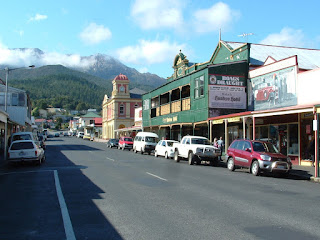We camped that night at Triabunna which is close to where the ferry
leaves for Maria Island. It was cold but waking early enabled
me to take some beautiful views of the sunrise over the
harbour. Maria Island was declared a National Park in 1972
and offers an interesting history of convict and industrial ruins.
It is also appealing for its beautiful natural features such as
beaches, forests and limestone cliffs.
 |
| Sunrise at Triabunna |
After exploring the old Commissariat Store and remains of the
Darlington convict village, I did the 4-hour return hike up a peak
called Bishop and Clerk. This is the highest point of the island.
It offered great views back towards the mainland and out to sea in
the other direction. The highlight for me though was seeing the art
of nature so beautifully in the Painted Cliffs. These
extraordinary cliffs have been stained various colours by water
running down their rock faces.
| Painted Cliffs, Maria Island |
After the ferry returned us to Triabunna we drove south to Kettering
for the ferry across to Bruny Island the next morning.
We arrived 20 minutes before the sailing at 7.45am and
couldn't understand why we were the only car waiting and there were
no crew anywhere. It didn't take too long to realise that
daylight saving had finished and we were actually an hour early!
The islands of North and South Bruny are separated by a thin strip of
sand dunes called The Neck. They are both rugged and very scenic,
especially the south. Our initial destination was Adventure Bay
- a place with a rich history of whaling stations and a shelter for
explorers like Tasman and Cook. I did the Fluted Cape walk
there and although light rain spoiled views out to sea, the
highlight of the walk is awesome sea cliffs. Bruny is famous
for its wildlife and as I returned to the car and I was fortunate to
see a rare albino wallaby.
 |
| Dennes Point, North Bruny Island |
We did a walk around Cloudy Bay before going to Cape Bruny on the
southern coast of the island. This windswept point has an old
lighthouse built in 1836 that has expansive views over to mainland
Tasmania’s southernmost reaches. The cold southerly wind
meant we didn't stay there very long and drove right up to Dennes
Point at the northern tip of the island. It was a much warmer
and more pleasant place to wait for the ferry which departed early
evening.

















